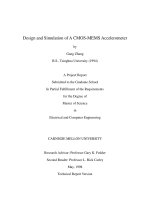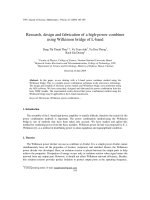design and analysis of a compact 6port microstrip mimo antenna for 24ghz wlan applications
Bạn đang xem bản rút gọn của tài liệu. Xem và tải ngay bản đầy đủ của tài liệu tại đây (442.98 KB, 7 trang )
<span class='text_page_counter'>(1)</span><div class='page_container' data-page=1>
<b>DESIGN AND ANALYSIS OF A COMPACT 6-PORT MICROSTRIP </b>
<b>MIMO ANTENNA FOR 2.4-GHz WLAN APPLICATIONS </b>
<b>Nguyen Thi Kim Thu, Nguyen Phuc Ngoc, Nguyen Thi Quynh Hoa </b>
<i>School of Engineering and Technology, Vinh University </i>
Received on 25/01/2019, accepted for publication on 28/3/2019
<b>Abstract: </b>A compact 6-port MIMO antenna consisting of equilateral triangle
elements have demonstrated in order to miniaturize the size and reduce the mutual
coupling of antenna elements due to its geometrical shape. The antenna is designed on
FR4 material and simulated results by HFSS software are provided. The simulated
results show that the proposed MIMO antenna achieves the return loss of less than -10
dB and the mutual coupling of less than -12.5 dB between elements in a bandwidth
ranging from 2329 to 2495 MHz, which entirely covers WLAN frequency band
allocated from 2400 MHz to 2480 MHz. The obtained results indicate that the
proposed antenna is a good candidate for MIMO applications.
<b>1. Introduction </b>
Multiple-Input-Multiple-Output (MIMO) technology has been widely applied for
wireless communication because it can offer significant increases in data throughput and
link range without using additional bandwidth or transmit power [1-9]. By using multiple
antennas in both the transmitter and receiver, the MIMO technique can detect multiple
independent channels in free space, which can achieve a higher capacity of a link
compared to the classic single-antenna design. Due to this unique feature, MIMO has
been adopted in all major wireless standards such as IEEE 802.11n (Wi-Fi), 4G, 3GPP
Long Term Evolution, WiMAX and HSPA+ [2].
However, a multi-antenna system has just the best performance when the mutual
coupling among the antenna elements is low because a strong coupling can lead to not
only high correlation but also a severe loss in efficiency of multi-antenna systems. The
low mutual coupling can also be obtained by utilizing large spatial separation among
antennas, which has an effect on the size of the overall antenna system. Thus, the design
of MIMO antenna is still a very challenging task for obtaining both low mutual coupling
and compact size because these features remain controversial [1-8].
Many approaches have been reported to reduce the mutual coupling of antenna
elements such as the usage of modified ground [3], neutralization-line [4], orthogonal
polarizations [2], [5], [6], parasitic coupling elements techniques [7] and the utilization of
metamaterials [8]. However, these structures are wavelength - related, which makes them
difficult to apply in an ultra-compact MIMO antenna design [1].
</div>
<span class='text_page_counter'>(2)</span><div class='page_container' data-page=2>
so far. Even though, compared to antennas with other patch geometries, the triangular
microstrip antenna has advantages such as smaller physical size and lower radiation loss
[13]. Furthermore, a triangular patch has a great capability of miniaturization of MIMO
antenna due to its geometrical shape.
In this letter, a compact six-port microstrip MIMO antenna using equivalent
triangular patches designed for the 2.4 GHz WLAN band is proposed, simulated and
evaluated. In this configuration, both low mutual coupling characteristics and
miniaturization are realized.
<b>2. Antenna Design </b>
Design parameters of the proposed MIMO antenna are shown in Fig. 1. The
dimension of the overall antenna structure is 70 mm x 70 mm fabricated on a FR-4
substrate with a dielectric constant of 4.4, a substrate thickness of 1.6 mm, and a loss
tangent of 0.02. The top and bottom patches printed on the substrate are the radiating
structure and the ground plane. We noted that the area per element of the proposed
MIMO of 0.16 λ2 is much smaller than that of other microstrip MIMO antenna such as
[2], [3], [5].
In the top layer, six equilateral triangle patches are rotationally symmetric with an
interval of 600. The dimensions of the equilateral triangle patch of 38.45 mm, designed
to operate at 2.4 GHz, the standard frequency for wireless LAN (WLAN), is calculated
using the formulas given in [14]. The separation between antennas is optimized at 2.5
mm. Six feeding ports are fed by coaxial cable. The feeding positions are located at the
median of the triangle as shown in Fig. 1a; these provide 50 Ω interfaces and achieve the
impedance matching at the desired frequency. The bottom layer of the substrate is just a
ground plane. The proposed MIMO antenna has been simulated by HFFS software.
70 mm
38.45 mm
6.72 mm
1
.9
9
m
m
F
e<sub>e</sub>
d
in
g
P
o
in
t
(a) (b)
</div>
<span class='text_page_counter'>(3)</span><div class='page_container' data-page=3>
<b>3. Results and Discussion </b>
<i><b>3.1. Scattering Parameters </b></i>
HFSS software was used to design, simulate and analyze the proposed MIMO
antenna. The simulated S-parameters were shown in Fig. 2. Since the radiating elements
are rotationally symmetric, only return loss in port one (S11) and the mutual coupling
between ports 1 and 2, 3, 4 (S12, S13, S14) are provided.
The proposed MIMO antenna exhibits the return loss (S11) of less than -10 dB
and the mutual coupling (S12) of less than -12.5 dB in a bandwidth ranging from 2329 to
2495 MHz, which entirely covers WLAN frequency band allocated from 2400 MHz to
2480 MHz [11]. The isolation is better than -12.5 dB in the whole matching band,
indicating that the proposed antenna is suitable for MIMO application [15]. We noted
that the obtained bandwidth of the proposed MIMO of 176 MHz is much larger than the
bandwidth of others MIMO antenna such as [1], [2].
<i><b>3.2. Voltage Standing Wave Ratio </b></i>
</div>
<span class='text_page_counter'>(4)</span><div class='page_container' data-page=4>
<b>Fig. 3: </b><i>VSWR of the proposed MIMO antenna</i>
<i><b>3.3. Smith Chart </b></i>
The scattering parameter S11 for the proposed MIMO antenna at the range of
frequencies 1.75 GHz - 3 GHz on the Smith chart is shown in Fig. 4. Because the
radiating elements are rotationally symmetric, the similar Smith charts of other ports are
observed. As shown in Fig. 4, the proposed antenna exhibits a good impedance matching
of approximately 50 Ohms at the resonate frequency.
<b>Fig. 4: </b><i>Smith chart of the proposed MIMO antenna </i>
<b>5.00</b>
<b>2.00</b>
<b>1.00</b>
<b>0.50</b>
<b>0.20</b>
<b>0.00</b>
<b>5.00</b>
<b>-5.00</b>
<b>2.00</b>
<b>-2.00</b>
<b>1.00</b>
<b>-1.00</b>
<b>0.50</b>
<b>-0.50</b>
<b>0.20</b>
<b>-0.20</b>
<b>0.00</b> <b>0</b>
<b>10</b>
<b>20</b>
<b>30</b>
<b>40</b>
<b>50</b>
<b>60</b>
<b>70</b>
<b>80</b>
<b>90</b>
<b>100</b>
<b>110</b>
<b>120</b>
<b>130</b>
<b>140</b>
<b>150</b>
<b>160</b>
<b>170</b>
<b>180</b>
<b>-170</b>
<b>-160</b>
<b>-150</b>
<b>-140</b>
<b>-130</b>
<b>-120</b>
<b>-110</b>
<b>-100</b> <b>-90</b> <b>-80</b> <b>-70</b>
<b>-60</b>
<b>-50</b>
<b>-40</b>
<b>-30</b>
<b>-20</b>
<b>-10</b>
HFSSDesign1
Smith Chart 3 ANSOFT
</div>
<span class='text_page_counter'>(5)</span><div class='page_container' data-page=5>
<b>Fig. 5: (</b><i>a) Gain of the proposed MIMO antenna, (b) Radiation pattern in XOZ plane, </i>
<i>and (c) YOZ when feeding port 1 </i>
<i><b>3.4. Radiation Patterns and Gain </b></i>
Radiation patterns and gain of the proposed antenna were shown in Fig.5. As
shown in Fig. 5a, the proposed antenna provides a total maximum gain of 3.19 dB. The
directional patterns of port 1 in XOZ and YOZ-plane are provided in Fig. 5 b,c. The 3-dB
beamwidth in the XOZ-plane covers 118o, which can not only provide good pattern
diversity to boost the channel capacity but also catch the signal from every angle.
<i><b>3.5. MIMO Performance </b></i>
For the antenna used for MIMO application, the correlation coefficient between
elements is an important parameter in evaluating performance. The correlation of a
two-port can be obtained using the two-two-port S parameter representation as [16].
2
* *
11 12 21 22
2 2 2 2
11 21 22 12
1 1
<i>S S</i> <i>S S</i>
<i>S</i> <i>S</i> <i>S</i> <i>S</i>
(1)
The correlation coefficient between port 1 and 2 is shown in Fig. 6. The obtained
correlation coefficient is lower than 0.03 dB in the whole matching band, which value is
sufficient to fulfill the diversity performance for the MIMO antenna [16].
<b>-27.00</b>
<b>-24.00</b>
<b>-21.00</b>
<b>-18.00</b>
<b>-15.00</b>
<b>-12.00</b>
<b>-9.00</b>
<b>-6.00</b>
<b>-3.00</b>
<b>90</b>
<b>60</b>
<b>30</b>
<b>0</b>
<b>-30</b>
<b>-60</b>
<b>-90</b>
<b>-120</b>
<b>-150</b>
<b>-180</b>
<b>150</b>
<b>120</b>
HFSSDesign1
Radiation Pattern 33 ANSOFT
Curve Inf o
dB10normalize(DirTotal)
Setup1 : LastAdaptive
Freq='2.4GHz' Phi='0deg'
<b>-21.00</b>
<b>-18.00</b>
<b>-15.00</b>
<b>-12.00</b>
<b>-9.00</b>
<b>-6.00</b>
<b>-3.00</b>
<b>90</b>
<b>60</b>
<b>30</b>
<b>0</b>
<b>-30</b>
<b>-60</b>
<b>-90</b>
<b>-120</b>
<b>-150</b>
<b>-180</b>
<b>150</b>
<b>120</b>
HFSSDesign1
Radiation Pattern 36 ANSOFT
Curve Inf o
dB10normalize(DirTotal)
Setup1 : LastAdaptive
Freq='2.4GHz' Phi='90deg'
(b) (c)
</div>
<span class='text_page_counter'>(6)</span><div class='page_container' data-page=6>
<b>Fig. 6: </b><i>The correlation coefficient of the proposed MIMO antenna. </i>
<b>4. Conclusions </b>
A compact 6-port MIMO antenna consisting of equilateral triangle elements has
demonstrated in order to miniaturize the size and reduce the mutual coupling due to its
geometrical shape for WLAN applications. The proposed MIMO antenna is simulated
and evaluated using HFSS software. The simulated results show that the proposed
antenna achieves the resonate frequency at 2.4 GHz, the impedance of 50 Ω, the
bandwidth of 176 MHz, the total gain of 3.19 dB and low mutual coupling of less than
-12.5 dB through the whole WLAN band. The obtained results prove that the antenna is
suitable for MIMO application.
<b>REFERENCES </b>
[1] Han Wang H., Liu L., Zhang Z., Li Y. and Feng Z., <i>Ultra-Compact Three-Port </i>
<i>MIMO Antenna with High Isolation and Directional Radiation Patterns</i>, IEEE
Antennas Wireless Propa. Lett.<i>, </i>13, 2014, pp. 1545-1548.
[2] Nigam H., Kumar M., <i>Design and Analysis of 2x2 MIMO System for 2.4 GHz ISM </i>
<i>Band Applications</i>, International Journal of Advanced Research in Computer
Engineering & Technology<i>, </i>3, 2014, pp. 1794-1798.
[3] OuYang J., Yang F., and Wang Z. M., <i>Reducing mutual coupling of closely spaced </i>
<i>microstrip MIMO antennas for WLAN application</i>, IEEE Antennas Wireless Propag.
Lett.<i>, 1</i>0, 2011, pp. 310 - 313.
[4] Su S.-W., Lee C.-T. and Chang F.-S., <i>Printed MIMO-antenna system using </i>
<i>neutralization-line technique for wireless USB-dongle applications</i>, IEEE Antennas
Wireless Propag. Lett<i>., </i>60<i>,</i> 2012,pp. 456-463.
[5] Babu K. J, Krishna K. S. and Reddy L. P., <i>A multi slot patch antenna for 4G MIMO </i>
<i>communications</i>, International Journal of Future Generation Communication and
Networking<i>, </i>4, 2011, pp. 105-112.
[6] Gao C., Li X.-Q., Lu W. J., Wong K.-L., <i>Conceptual design and implementation of a </i>
<i>four-element MIMO antenna system packaged within a metallic handset (2018),</i>
</div>
<span class='text_page_counter'>(7)</span><div class='page_container' data-page=7>
[7] Li et al., <i>Reducing mutual coupling of MIMO antennas with parasitic elements for </i>
<i>mobile terminals</i>, IEEE Trans. Antennas Propag<i>., </i>60, 2012, pp. 473-481.
[8] Zhai G., Chen Z. N., Qing X., <i>Enhanced Isolation of a Closely Spaced Four-Element </i>
<i>MIMO Antenna System using Metamaterial Mushroom</i>, IEEE Trans. Antennas
Propag.<i>, </i>63, 2015, pp. 3362- 3370.
[9] Nasir J., Jamaluddin M. H., Khalily M., Kamarudin M. R., Ullah I., <i>Design of a </i>
<i>MIMO Dielectric Resonator Antenna for 4G Applications,</i> Wireless. Pers.
Commun., 2016. DOI. 10.1007/s11277-016-3174-3.
[10] R. Pavithra, R., Mohanageetha D., Mary Anita, E. A., Subramaniam M.<i>, A New </i>
<i>Compact Microstrip Integrated E-Array Patch Antenna with High Gain and High </i>
<i>Aperture Efficiency,</i> Wireless. Pers. Commun.,78, 2014,pp.1011-1020.
[11] Afrough M., Fakharian M. M., Tavakol-Hamedani F., <i>Compact Dual-Band </i>
<i>Suspended Microstrip Slot Antenna with an Antipodal Parasitic Element for WLAN </i>
<i>Applications,</i> Wireless. Pers. Commun., 83, 2015, pp. 571-579.
[12] Hamed H. and Ghouz M., <i>Novel Compact and Dual-Broadband Microstrip MIMO </i>
<i>Antennas for Wireless Applications,</i> Progress in Electromagnetics Research B, 63,
2015, pp. 107-121.
[13] Hassani H. R., Mirshekar-Syahkal D., <i>Analysis of Triangular Patch Antennas </i>
<i>Including Randome Effects,</i> IEEE Proc. H Microwave and Prop.,<i> 139</i>, 1992, pp.
251-256.
[14] Bahl I. J., Bharta P., <i>Microstrip Antenna, </i> Artech House, Massachusetts, USA,
1980.
[15] Muhammad Sajjad Ahmad, Wahab Mohyuddin, Hyun Chul Choi and Kang Wook
Kim, <i>4x4 MIMO antenna design with folded ground plane for 2.4 Ghz WLAN </i>
<i>applications,</i> Microw Opt Technol Lett,<i> 5,</i>2018, pp. 395-399.
[16] Ren J., Hu W., <i>Compact Print MIMO Antenna for UWB Applications,</i> IEEE
Antennas Wireless Propa. Lett.,<i> 13</i>, 2014, pp. 1517-1520.
<b>TĨM TẮT </b>
<b>PHÂN TÍCH VÀ THIẾT KẾ ANTEN MIMO 6 CỔNG KÍCH </b>
<b>THƯỚC NHỎ CHO ỨNG DỤNG WLAN </b>
</div>
<!--links-->









